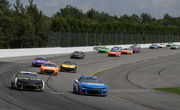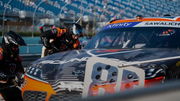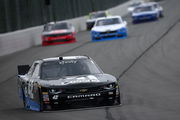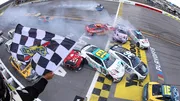
via Imago
NASCAR, Motorsport, USA Daytona 500 Feb 19, 2023 Daytona Beach, Florida, USA NASCAR Cup Series drivers Justin Haley 31, Todd Gilliland 38, Austin Cindric 2, Austin Dillon 3, William Byron 24, Jimmie Johnson 84 and Noah Gragson 42 crash during the Daytona 500 at Daytona International Speedway. Daytona Beach Daytona International Speedway Florida USA, EDITORIAL USE ONLY PUBLICATIONxINxGERxSUIxAUTxONLY Copyright: xMarkxJ.xRebilasx 20230219_mjr_su5_022

via Imago
NASCAR, Motorsport, USA Daytona 500 Feb 19, 2023 Daytona Beach, Florida, USA NASCAR Cup Series drivers Justin Haley 31, Todd Gilliland 38, Austin Cindric 2, Austin Dillon 3, William Byron 24, Jimmie Johnson 84 and Noah Gragson 42 crash during the Daytona 500 at Daytona International Speedway. Daytona Beach Daytona International Speedway Florida USA, EDITORIAL USE ONLY PUBLICATIONxINxGERxSUIxAUTxONLY Copyright: xMarkxJ.xRebilasx 20230219_mjr_su5_022
Daytona International Speedway is always an exciting track, starting the season with a bang every year. Of course, it’s not just the opening show; that’s where myths are made or broken. We can think of it as free competition. But at the same time, it’s not everyone’s cup of tea. The track is known for its grueling turns, and often dramatic arenas, and has seen many life-altering incidents unfold. Just look at Dale Earnhardt, who finally made it and won the 1998 Daytona 500 crown after a two-decade chase, and in 2001 met his unfortunate end on the same asphalt.
However, there’s one intriguing thing. The statistics remind everyone of how times have changed. Of the top 20 winners at Daytona International Speedway, only one driver from the current class has made the list. This is a fairly significant difference, but it begs the question, why such a big difference? What has really changed?
ADVERTISEMENT
Article continues below this ad
Why didn’t the new-school NASCAR drivers experience the legendary glory days of the 80s and 90s at Daytona?
NASCAR’s ultimate icon, Richard Petty, shone brightly on Daytona’s biggest stage. His unforgettable Daytona victory was in 1979, the first race fully broadcast by CBS, that cemented his place with seven victories in the American Grand Prix.
Cale Yarborough played a pivotal role in taking NASCAR from its southern origins to nationwide action. His victory at Daytona in 1977 not only cemented his place in history but also landed him on the cover of the iconic magazine, Sports Illustrated. Along with nine Cup race victories at Daytona, Yarborough’s racing record includes four Daytona 500 victories and four top-5 and 10 finishes. David Pearson, with eight wins from 71 starts, and legends like Fireball Roberts, Bobby Allison, and Jeff Gordon, set a high standard, one that modern drivers seem to be struggling to reach, with only Denny Hamlin as the current racer who made it to the top 20 list. So, what has changed?
For starters, the legends included cars like Thunderbird and Plymouth engineered by NASA’s Gary Romberg and others for Richard Petty. By the time they were driven, success was almost a given. Fast forward to today, and we’ve switched from the powerhouse Gen-6 to the more regulated Gen-7 car, summoning horsepower from a thunderous 900 to a more restrained 550 for plate racing, and back to 670 for others.
These changes, however, are not limited to Daytona but are all over the track, transforming what was once a test of raw power into smarter and more sporty ways. But there’s more to the old guard’s success than just better equipment.
Watch This Story: Toy Story Actor Tim Allen Once Competed in the Rolex 24 Hours of Daytona
ADVERTISEMENT
Article continues below this ad
Trending
Were old-school drivers more involved in their cars than current-generation drivers?
Back in the day, legends like Dale Earnhardt and Harry Gant were practically joined at the hip with their rides, getting their hands dirty alongside their teams, whereas today it’s like the new crop of drivers are relying more on the pit crew tech wiz.
And because it behaves more like a cerebral game, it turns into a playground for mechanics, with many young guns not delving deep enough into the frames and wires of their machines, except to perhaps just roll over and blow off the gas. These changes have seen the relationship between drivers and their pit crew expand each year.
ADVERTISEMENT
Article continues below this ad
Read More: Dwayne Johnson Set to Serve as the Grand Marshal for Daytona 500
However, the issue extends beyond just the activities in the garage area. Drivers not being fully aware of their own machinery often manifests itself during the races, where some cars fail unexpectedly, and the ones sitting behind the wheels are not even able to know what the issue is. Well, what else do you think could be the reason behind the fact that today’s young drivers aren’t able to cross the finish line as often as Daytona leads?
ADVERTISEMENT
ADVERTISEMENT
ADVERTISEMENT
ADVERTISEMENT






